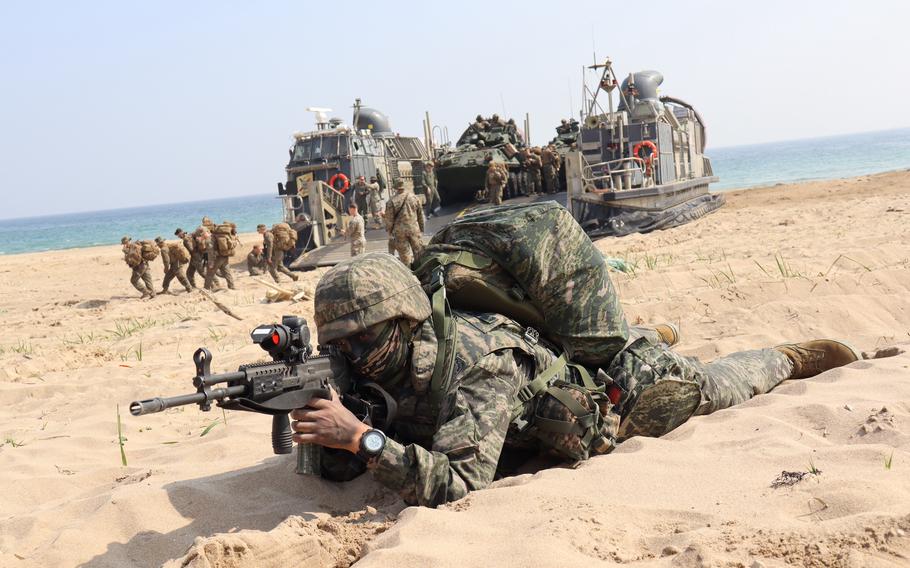
A South Korean marine takes his position as U.S. Marines from the 13th Marine Expeditionary Unit disembark from a landing craft during the Ssangyong Exercise in Pohang, South Korea, March 29, 2023. (David Choi/Stars and Stripes)
POHANG, South Korea — Dozens of U.S. Marines and their South Korean counterparts stormed a beachhead Wednesday near this port city on South Korea’s southeastern coast for a military exercise on a scale not seen in five years.
The amphibious landing drill on a Pohang beach roughly 150 miles from Seoul brought together over 30 ships, including the amphibious assault ship USS Makin Island and the two dock ships of its amphibious ready group. Around 70 aircraft and over 50 South Korean amphibious assault vehicles also took part, according to a statement from the South Korean marine corps headquarters.
South Korean marines in their assault vehicles landed first and set up a perimeter. Next came U.S. Marines of the 13th Marine Expeditionary Unit in Navy air-cushioned landing craft that sprayed sand into the air as they made landfall.
South Korean F-35A Lightning II fighters and Marine Corps V-22 Osprey tiltrotor aircraft roared overhead as the joint marine force established its beachhead.
Marine Corps Lt. Col. Eric Olson, the 13th MEU’s executive officer, characterized the drill as a defensive exercise and thanked South Korea’s military for its hospitality.
“This exercise is designed for the combined defense of the Korean Peninsula and that’s important to us and it’s important for regional stability,” Olson said in brief remarks to reporters. “Equally important is the interaction that we have with the marines and sailors from [South Korea].”
South Korean marine Col. Yoo Chang Hoon told reporters the drill reaffirmed the “sturdy alliance” with U.S. Marines.
“Our marine forces will immediately punish enemies in the event of any provocations and establish a posture for decisive battles,” Yoo said.
The amphibious landing drill is part of the wider Ssangyong Exercise and involved 2,500 U.S. Marines and sailors and 3,000 of their South Korean counterparts. Ssangyong translates to “double dragons,” a reference to the U.S. and South Korea military alliance.
The two-week Ssangyong Exercise concludes Monday. Conducted at sites around the Korean Peninsula, it is the largest U.S.-South Korean maritime drill since 2018. The aircraft carrier USS Nimitz, with its strike group, air wing and about 7,000 sailors and Marines, arrived Tuesday at Busan, South Korea’s largest port, to take part in the exercise.
Around 30 British Royal Marines also participated for the first time by conducting reconnaissance from mountain observation posts, Royal Navy Commodore Andy Lamb told Stars and Stripes on Wednesday.
Those Royal Marines “dug into their observation posts, completely invisible, for several days now,” Lamb said.
“I think it reminded them of the difficulties of operating far from home and integrating into forces that they don’t typically operate with,” Lamb said. “That’s hard.”
Joint exercises like Ssangyong were scaled back in 2018 when former South Korean President Moon Jae-in and former President Donald Trump attempted to lower tensions with North Korean leader Kim Jong Un.
Those negotiations collapsed in 2019 following a dispute over the denuclearization of North Korea and the U.S.’s sanctions against the regime. South Korean President Yoon Suk Yeol vowed to restart and increase the scale of the drills as North Korea continued to launch ballistic missiles in violation of U.N. Security Council resolutions.
North Korea’s state-run Korean Central News Agency characterized the exercises as a declaration of war and warned it would raise tensions on the peninsula. The communist regime has fired 11 ballistic missiles so far this year; including two short-range ballistic missiles on Monday.